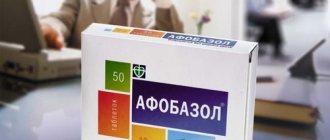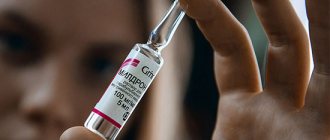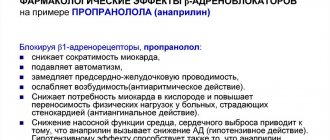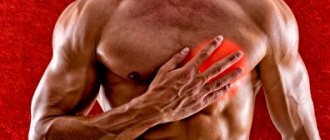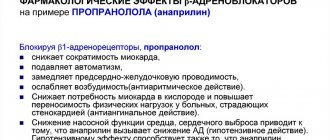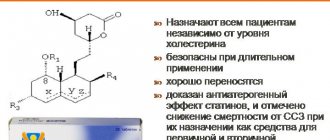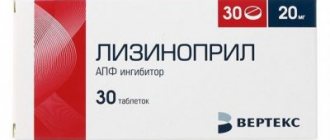We are surrounded by a huge number of factors that cause stress, anxiety, tension, poor sleep, anxiety, and depression. Rest and change of environment are universal remedies, but sometimes they turn out to be insufficient, do not bring relief, anxiety states intensify, all this affects the usual rhythm of life. At this point you should consult a doctor. There is nothing shameful or wrong about this, because constant stress negatively affects the entire body, especially the cardiovascular system. If the indications are clear, the doctor may prescribe Afobazole.
Afobazole is a medicine belonging to the group of anxiolytics (tranquilizers). It has a moderate stimulating effect, and at the same time reduces anxiety. Mild sedation is more of a side effect than the main manifestation of the use of anxiolytics.
Afobazole effectively copes with stress, tension and anxiety
What is Afobazol needed for?
Tranquilizers inherently affect benzodiazepine receptors (unlike the drug Afobazol), that is, they depress the nervous system, eliminate bad mood and nullify negativity, causing indifference. Moreover, tranquilizers can be addictive, which means that when the course ends, a “withdrawal syndrome” will appear. But don’t be afraid of the word “tranquilizer” in the description of the drug. Afobazole is a so-called “mild” or “daytime” tranquilizer. The active component of the drug actually has a tranquilizing effect, reduces severe anxiety, but does not affect benzodiazepine receptors. That is, Afobazol tablets do not suppress the central nervous system, do not cause dependence, drowsiness, muscle relaxation, do not reduce memory, do not dull emotions, and they do not have a withdrawal syndrome.
Afobazole relieves tension from the muscles of the hollow organs and reduces the manifestation of vegetative-somatic disorders (dry mouth, sweating, dizziness).
Afobazole is prescribed for the therapeutic treatment of anxiety in people over 18 years of age, which is provoked by mental disorders or external traumatic factors. If a person has self-doubt, increased vulnerability and suspiciousness, poor resistance to stress and emotional instability, then the effect of the drug Afobazol will be more pronounced.
The condition of a person taking Afobazole improves after about a week of regular use of the drug. The following effects are noted:
- anxiety and fear disappear;
- sleep improves;
- relieves nervous tension and psychological discomfort;
- the manifestation of vegetative-somatic disorders decreases;
- attention and memory improves.
Combination with other substances and medications
To avoid adverse consequences, the attending physician himself prescribes all necessary and additional medications.
Afobazole can be used with carbamazepine and diazepam, but in certain dosages.
Alcohol reduces the effectiveness of the drug, but despite this, hangover and anxiety are quickly eliminated. All this happens due to the fact that:
- starch prevents ethyl alcohol from being absorbed;
- milk sugar fights lethargy and apathy;
- Povidone, together with cellulose, promotes the rapid elimination of toxins;
- stearic acid relieves irritation;
- for withdrawal symptoms, take two tablets per day.
The effect of soothing herbal infusions and antidepressants is enhanced.
Indications
Indications for the use of the drug Afobazol are:
- increased anxiety, mental disorders, worries not associated with any specific subjects and objects, asthenic neuroses, adaptation disorders;
- anxiety disorders caused by various dermatological, oncological, somatic (lupus, hypertension, bronchial asthma, coronary artery disease, arrhythmia, etc.) and other diseases;
- anxiety states observed during VSD (in combination with other measures, since drug therapy for vegetative-vascular dystonia only temporarily relieves symptoms, but does not eliminate disturbances in the functioning of the nervous system);
- sleep disturbances resulting from increased anxiety;
- neurocirculatory dystonia (NCD);
- premenstrual syndrome in women (PMS);
- alcohol withdrawal (alcohol withdrawal syndrome);
- nicotine withdrawal.
Side effects and interactions
In the first days of treatment, a reaction from the nervous system is occasionally recorded:
- mild dizziness;
- drowsiness.
After the body adapts to the drug, they disappear on their own. Exceeding recommended doses does not lead to severe intoxication.
With the simultaneous use of Afobazol and Diazepam, the nootropic effect is enhanced. An antiepileptic effect may be observed when used together with Carbamazepine.
How to take Afobazol?
Afobazol tablets are taken after meals with a glass of clean water. One tablet contains 10 mg of the substance. Per day, according to the instructions for use, you can drink 30 mg. This dose is considered the maximum and should be divided into 3 doses throughout the day.
How to take Afobazol correctly
The duration of the therapeutic course is determined solely by the treating specialist. Since Afobazol does not accumulate, there is no addiction or dependence on the drug. That is why on average the therapeutic course lasts from 2-4 weeks. If the patient’s condition reveals the need for adjustments in taking the drug Afobazole, the doctor may prescribe doubling the daily dose (60 mg) and prolonging treatment for up to 3 months. Then a 1-2 week break is required. At this time, the therapeutic effect remains.
Effect of the drug
Does afobazole increase or decrease blood pressure? This drug does not have a direct effect on the cardiovascular system.
During stressful and emotional situations, a sharp jump in blood pressure often occurs. To normalize it, take afobazole, which balances the mental state.
Afobazole can increase blood pressure during hypotension due to the fact that it tones the entire body.
When the drug affects hypertension, the pressure returns to normal due to the expansion of the walls of blood vessels. But do not forget that this tranquilizer does not have a direct effect on the heart muscle. It removes the stress response, so the production of stress factors and hormones (adrenaline, norepinephrine) stops. During stress, the adrenal glands produce adrenaline and norepinephrine, which increase muscle tone, narrow the lumen of blood vessels, blood pressure rises, the heart muscle begins to contract faster, but at the same time, blood flow to non-vital organs decreases. Therefore, for hypertension, afobazole is not the main medicine for lowering blood pressure; it only reduces and eliminates the stress reaction.
Afobazole also tones all the blood vessels of the body, normalizes blood circulation and metabolic processes.
Reduces sweating and restores moisture in the mucous membranes, has a beneficial effect on the digestive and respiratory systems, improves their functioning and prevents the development of various pathological processes.
Pregnancy and breastfeeding period
Afobzaol should not be taken by pregnant women.
Since there are no reliable clinical studies and data on the effect of Afobazole tablets on the body of a pregnant woman, nursing mother, fetus and child, taking Afobazole is prohibited. During breastfeeding (lactation), since the active component passes into breast milk, it is necessary to consult with the supervising obstetrician-gynecologist and transfer the child to artificial formula.
Composition and appearance
The drug, which was recently produced by a pharmaceutical company from Russia, has managed to gain popularity as one of the best remedies to quickly stop the attack of depression. Afbezol is produced in the form of white tablets that are tasteless and odorless. In pharmacies the drug is sold in blisters # 25, 10 or in small polymer jars after 50, 100 and 30 pieces.
The active substance is Fabomotisol hydrochloride, which contains additional substances such as:
- lactose;
- starch;
- cellulose;
- magnesium stearate;
- Milk sugar.
This agent may reduce high blood pressure if it is associated with stress because it relieves nervous tension and anxiety. Tablets are available in 10 and 5 mg active ingredient strengths.
Analogs
The pharmaceutical market provides a fairly wide range of analogues of Afobazol tablets in terms of therapeutic effect. Among these drugs are Fabomotizol, Tenoten, Grandaxin, Stresam, Mebicar, Adaptol, Tranquilar, Novo-Passit, Grandaxin, Persen, Phenibut. Their effectiveness in a particular clinical case can only be assessed by the attending physician. It all depends on the individual tolerance of the active substance and components, the patient’s well-being, the individual characteristics of his body, and the severity of symptoms. Therefore, before buying a medicine at a pharmacy or replacing one with another, consult your doctor.
Analogs of the drug for therapeutic effect
Adaptol , for example, just like Afobazol, is effective, low-toxic, does not cause drowsiness, addiction and, accordingly, withdrawal syndrome. It has a positive effect on cognitive functions and eliminates moderate heart pain that is not related to angina pectoris. Unlike Afobazole, Adaptol is used in pediatrics. It is approved for use by children from 10 years of age.
Tenoten is used as a sedative and nootropic. It strengthens the central nervous system, improves memory and increases concentration, and stimulates the body's resistance to stress. Tenoten, unlike Afobazole, is used to treat children from 3 years of age.
Novo-Passit is used as a muscle relaxant that has a hypnosedative effect. It is prescribed for the treatment of anxiety and psycho-emotional stress. Unlike Afobazole, Novo-Passit is a combination of medicinal plant extracts and guaifenesin. Novo-Passit can be used by children from 12 years of age. However, given the composition of the drug Novo-Passit, adverse reactions in the form of allergies are more pronounced with the drug than with Afobazole.
Another effective analogue of the drug Afobazol is Grandaxin . It is indicated for fairly severe stress, increased and pronounced anxiety, deep depression and panic attacks. Grandaxin can be prescribed during pregnancy, excluding the first trimester. But for such effectiveness you have to pay for a rather large list of side effects.
Persen is a herbal preparation with a targeted sedative effect. It has shown itself well in the treatment of insomnia and increased irritability. Persen normalizes the emotional state and sleep, but it is worth remembering that the plant base can cause a number of side effects (most often allergic reactions). But Persen does not eliminate the cause of the symptoms described above. Whereas Afobazol has a targeted effect.
Phenibut and Afobazole are tranquilizers. Also, Phenibut is a nootropic. It is low-toxic and, unlike Afobazole, is used for the treatment of children over 8 years of age in the prevention of motion sickness, treatment of tics and stuttering.
The influence of Afobazole on the quality of life of cardiac patients during inpatient treatment
The short stay of the patient in the hospital (about 2–3 weeks) poses the attending physician the task of finding effective techniques that affect quality of life in the most common nosological forms: hypertension (HTN) and coronary heart disease (CHD). This pathology is accompanied by a diverse range of subjective symptoms of maladjustment (general weakness, increased fatigue, deterioration of memory and ability to concentrate, anxiety, decreased mood, and others), which are constantly in the focus of the patient’s attention, and not the blood pressure numbers or the electrocardiogram curve - important objective criteria from a doctor's point of view. Such a discrepancy in views leads to the destruction of the therapeutic alliance between the doctor and the patient, disappointment from contact and the formation of a negative attitude toward following recommendations upon discharge, regardless of the correct drug therapy in accordance with the standards of treatment. The prevalence of adaptation disorders in cardiological practice reaches 51%, the treatment of which seems to be a difficult and at the same time urgent task. Over the past decades, in the treatment of borderline mental disorders, priority has been given to benzodiazepine tranquilizers; Using epidemiological data, a constant increase in their consumption has been established. Long-term use of tranquilizers has shown their wide therapeutic potential. Negative manifestations of the clinical effects of benzodiazepines include side effects, including hypnosedative and muscle relaxant effects, depression of cognitive functions and a decrease in daily activity, changes in tolerance with long-term use and the presence of a predisposition to addictive mental disorders. In the early 80s of the 20th century, the leading laboratories in the world raised the question of creating a drug that would correspond in its anti-anxiety properties to benzodiazepine tranquilizers, but would be free of hypnosedative, muscle relaxant and “amnestic” effects. At the State Research Institute of Pharmacology named after. V.V. Zakusov RAMS, as a result of 15 years of research, the original anxiolytic Afobazole with an optimal balance of safety and effectiveness was obtained [12]. Purpose of the study. To evaluate the effect of Afobazole on the quality of life of cardiac patients during inpatient treatment in the presence of psychosomatic disorders. Material and methods QoL was studied using the international adapted SF-36 methodology [8,14,15] in 95 cardiac patients who were in hospital (23 people with stage II hypertension and 22 with coronary artery disease, angina pectoris of functional class II), who During the first 10 days of hospital stay, Afobazole was additionally prescribed at a dose of 10 mg 3 times a day due to the presence of adaptation disorders. A comparative analysis of the dynamics of quality of life for the same period was carried out in a group of 27 patients with stage II hypertension and 23 patients with coronary artery disease: angina pectoris of functional class II against the background of traditional treatment using phenazepam 25 mg at night. Standard therapy according to the formulary system for hypertension and coronary artery disease included b-blockers, ACE inhibitors, and statins. Statistical data processing was carried out using paired Student's t test using the SPSS software package, version 10.0. Results and discussion In clinical settings, the safety and effectiveness of Afobazole in the treatment of borderline mental disorders has been shown: in psychiatry, cardiology, endocrinology and obstetric and gynecological practice [1–12]. The study of the effect of Afobazole on the quality of life of patients with hypertension was preceded by a study of this indicator in 27 patients against the background of standard therapy. The results of statistical data processing are presented in Table 1 and Figure 1. The results of statistical processing of the SF-36 test against the background of standard therapy revealed an improvement in the quality of life on the SF scale at the trend level, the P criterion was 0.059. In the group of patients taking Afobazole, the quality of life profile significantly changed in several indicators, as shown in Table 2 and Figure 2. The data obtained indicate a significant improvement in the quality of life of patients according to the B, OH and F scales of the SF-36 test. Improvement in scores on the B scale indicates an increase in the ability of patients to engage in daily activities, including housework and outside the home. The OZ scale reflects the patient’s best assessment of his current condition and treatment prospects, and an increase in indicators on the F scale reflects an increase in vital activity. During Afobazole therapy, the tendency (p=0.089) for patients to increase social contacts remained [8]. Ten-day therapy of patients with coronary artery disease did not affect the improvement of their quality of life, either when using standard prescriptions or when taking additional Afobazole. The dynamics of QOL after a course of therapy with Afobazole in the study group of patients are presented in Table 3 and Figure 3. Based on the study of test indicators, an improvement in the QOL of role-emotional functioning was found at the level of a trend (p = 0.68), which suggests a decrease in the influence of the patient’s emotional state on the performance of them in daily activities (including large amounts of time spent, a decrease in the amount of work, a decrease in its quality) and mental health (p = 0.097), which corresponds to a decrease in anxiety and depressive symptoms [8]. Conclusion Thus, a course of treatment with Afobazole for patients with hypertension and coronary artery disease for ten days against the background of standard therapy in a hospital setting allows one to obtain a significant improvement in the quality of life in patients with hypertension, its physical and psychological components. Considering that the maximum effect from taking this drug occurs after 4 weeks, it should be concluded that this drug has the potential to influence the quality of life in patients with coronary artery disease, which, of course, can only be stated after further studies in the conditions of outpatient use of Afobazole until the symptoms of maladaptation are completely eliminated or stabilization of psychosomatic status.
Literature 1. Avedisova A.S. New anxiolytic “Afobazol” in the treatment of generalized anxiety disorder (results of a comparative study with diazepam) / Journal. Psychiatry and psychopharmacotherapy (extra-issue). – 2006. – P.13–16. 2. Avedisova A.S., Chakhaeva V.O. The use of the anxiolytic afobazole in the treatment of generalized anxiety disorder (information letter). – M., 2006. – 12 p. 3. Akarachkova E.S. Afobazole is a modern pathogenetic therapy for patients with neurocirculatory dystonia/breast cancer. – T.14, – No. 16. – 2006. – P.11–13. 4. Antonova K.V. thyrotoxicosis. Mental change. Treatment options/breast cancer. – T.14, – No. 13. – 2006. – P.14–15. 5. Buldakova N.G. Psychopharmacotherapy in cardiology/breast cancer. – T.14, – No. 10. – 2006. – P.8–10. 6. Vasilyeva A.V., Poltorak S.V., Polyakov A.Yu., Solomonova S.V. The use of afobazole in the complex treatment of adaptation disorders/Journal. Psychiatry and psychopharmacotherapy (extra-issue). – 2006. – P.24–26. 7. Neznamov G.G., Syunyakov S.A., Chumakov D.V., Teleshova E.S., Davydova I.A., Grishin S.A., Mametova L.E., Syunyakov T.S. New anxiolytic afobazole: results of a comparative clinical study with diazepam in generalized anxiety disorder / Journal. Psychiatry and psychopharmacotherapy (extra-issue). – 2006. – P.17–23. 8. Novik A.A., Ionova T.I. Guidelines for quality of life research in medicine. – St. Petersburg: Publishing House “Neva”; M.: “OLMA-PRESS Star World”, 2002. – 320 p. 9. Pogosova G.V. Modern approaches to the diagnosis and treatment of depressive spectrum disorders in general medical practice (a manual for doctors) / Scientific and practical peer-reviewed medical journal (appendix). – No. 1., 2007. – 24 p. 10. Serov V.N., Baranov I.I. Tranquilizers in obstetrics and gynecology practice/breast cancer. – T. 14, – No. 18. – 2006. – P.3–7. 11. Smulevich A.B., Andryushchenko A.V., Romanov D.V. Psychopharmacotherapy of borderline anxiety disorders (comparative study of the anxiolytic effect of Afobazole and oxazepam in patients with adaptation disorders and generalized anxiety disorder)/BC. – T.14, – No. 9. – 2006. – P.3–7. 12. Smulevich A.B., Andryushchenko A.V., Romanov D.V., Siranchieva O.A. Therapy of borderline mental disorders (study of the effectiveness and tolerability of afobazole)/Mental disorders in general medicine. – No. 1. – 2006. – P.10–16. 13. Nilsson P., Brandstrom H., Lingfors H., Erhardt L., Hedback B., Israelsson B., Sjoberg G. National program of quality assurance in secondary prevention in Sweden. Gender differences in secondary prevention of coronary heart disease: reasons to worry or not?//Scand. J. Prim. Health Care. – 2003. – No. 21. – R.37–42. 14. Ware JE, Kosinski M., Keller SD SF–36 Physical and Mental Health Summary Scales: A User's Manual//The Health Institute, New England Medical Center. Boston, Mass. – 1994; https://www.rhinology.ru 15. Ware JE, Snow KK, Kosinski M., Gandek B. SF–36 Health Survery. Manual and interpretation guide//The Health Institute, New England Medical Center. Boston, Mass. – 1993. 16. Wehler M., Geise A., Hadzionerovic D., Aljukic E., Reulbach U., Hahn EG, Strauss R. Health–related quality of life of patients with multiple organ dysfunction: individual changes and comparison with normative population.//Crit. Care. Med. – 2003. – No. 31. – R.1094–1101.
